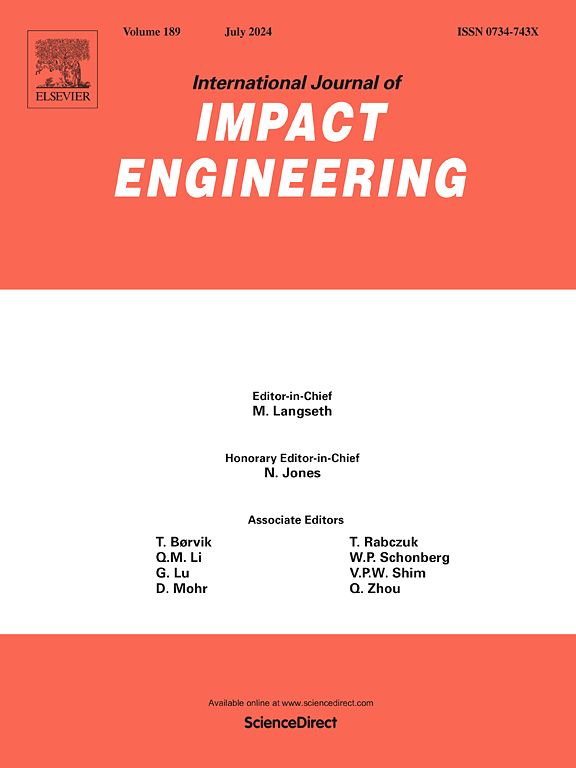78K ~ 1423K硬质保温瓦材料动态断裂韧性研究
IF 5.1
2区 工程技术
Q1 ENGINEERING, MECHANICAL
International Journal of Impact Engineering
Pub Date : 2025-06-23
DOI:10.1016/j.ijimpeng.2025.105451
引用次数: 0
摘要
这项工作利用增强的高温分裂霍普金森压力棒(SHPB)实验系统对孔隙率为~ 87%的刚性绝缘瓦(RIT)材料进行三点弯曲(3-p-b)测试,评估78 K至1423 K极端温度范围内的断裂韧性。基于温度变化对纤维间距的调节和惯性效应的影响,扩展了边界效应模型在动态高温环境中的应用。此外,实验结果表明,RIT材料的断裂韧性与温度和加载速率有显著关系。例如,从293 K到78 K,不同加载速率下的断裂韧性均显著增加,最大增幅为~ 34.69%。温度上升到粘脆转变温度(~ 973 K)。在不同加载速率下,粘滞流动和微裂纹自愈导致断裂韧性从973 K显著提高到1173 K,增幅超过25.97%。在原料烧成温度(~ 1473 K)附近,纤维压实和软化的主要断裂方式发生了根本变化,导致纤维在不同加载速率下的断裂韧性显著下降,最大降幅为33.77%。断裂分析结果表明,裂纹扩展模式和纤维断裂机制的显著差异导致了加载速率对断裂韧性的敏感性。这些研究结果将为评价RIT材料在极端温度和高加载速率下的断裂性能提供重要参考。本文章由计算机程序翻译,如有差异,请以英文原文为准。
Investigation into dynamic fracture toughness of rigid insulation tile materials ranging from 78K to 1423K
This work utilizes an enhanced elevated-temperature split Hopkinson pressure bar (SHPB) experimental system to perform three-point-bending (3-p-b) tests on rigid insulation tile (RIT) materials with a porosity of ∼87 %, assessing fracture toughness across a range of extreme temperatures spanning from 78 K to 1423 K. Based on the regulation of temperature change on fiber spacing and the influence of inertia effect, the application of boundary effect model (BEM) in dynamic elevated-temperature environment is expanded. Moreover, the experimental results indicate that the fracture toughness of RIT materials significantly dependent on temperature and loading rate. For example, from 293 K to 78 K, the fracture toughness at various loading rate increased significantly, with a maximum increase of ∼34.69 %. The temperature rises to the viscous-brittle transition temperature (∼973 K). Viscous flow and micro-crack self-healing lead to a significant increase in fracture toughness from 973 K to 1173 K at various loading rates, with an increase of more than 25.97 %. Near the raw material firing temperature (∼1473 K), the dominant fracture mode of fiber compaction and softening changed fundamentally, resulting in a significant decrease in fracture toughness at various loading rates, with a maximum decrease of 33.77 %. The fracture analysis results show that the significant difference in crack propagation mode and fiber fracture mechanism causes the loading rate sensitivity of fracture toughness. These findings will provide an important reference for evaluating the fracture properties of RIT materials under extreme temperature and high loading rate scenarios.
求助全文
通过发布文献求助,成功后即可免费获取论文全文。
去求助
来源期刊

International Journal of Impact Engineering
工程技术-工程:机械
CiteScore
8.70
自引率
13.70%
发文量
241
审稿时长
52 days
期刊介绍:
The International Journal of Impact Engineering, established in 1983 publishes original research findings related to the response of structures, components and materials subjected to impact, blast and high-rate loading. Areas relevant to the journal encompass the following general topics and those associated with them:
-Behaviour and failure of structures and materials under impact and blast loading
-Systems for protection and absorption of impact and blast loading
-Terminal ballistics
-Dynamic behaviour and failure of materials including plasticity and fracture
-Stress waves
-Structural crashworthiness
-High-rate mechanical and forming processes
-Impact, blast and high-rate loading/measurement techniques and their applications
 求助内容:
求助内容: 应助结果提醒方式:
应助结果提醒方式:


